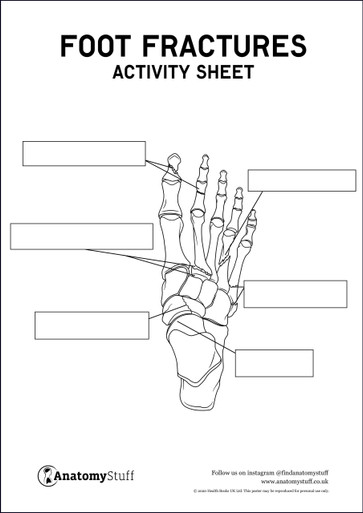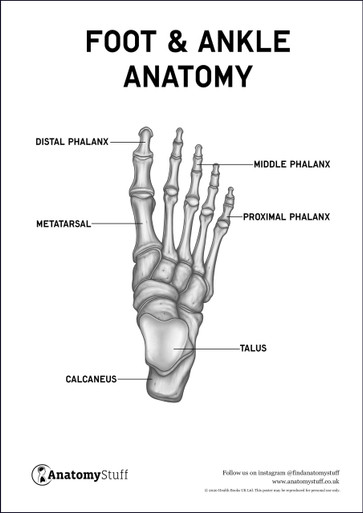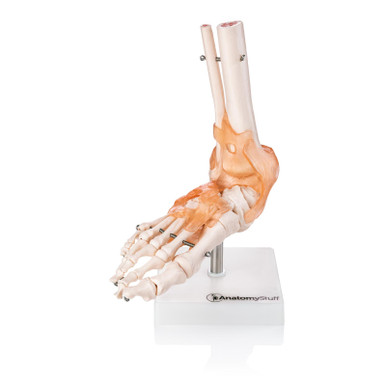Foot Fractures and Dislocations
Fractures of the foot can be caused by traumatic accidents, sports injuries or underlying conditions. The severity of a foot fracture typically depends on how much the bone has been displaced from its original position. Dislocations can also occur due to injury, and some injuries involve fractures and dislocations.
Foot Anatomy
Forefoot Anatomy
The forefoot consists of the metatarsal bones and the phalanges. The big toe is called the hallux and is unique because it contains two phalanges and one metatarsal bone. The hallux also has two small bones, which sit at the base of the toe, called sesamoid bones. These small bones help the toe push off the ground. The other toes are made from one metatarsal and three phalanges.
Midfoot Anatomy
The bones of the midfoot are called the navicular, cuboid, lateral cuneiform, medial cuneiform and intermediate cuneiform. The midfoot connects the forefoot to the hindfoot and helps to form the arches of the feet.
Hindfoot Anatomy
The hindfoot connects the midfoot to the ankle and comprises the talus and the calcaneus. The talus is an important bone because it has three articulations. The talus articulates with the end of the tibia and fibula, as well as the calcaneus and the navicular.
The calcaneus is your heel bone and acts as a lever during dorsiflexion and plantarflexion of the foot. This bone has a vital role in weight-bearing and providing stability during walking. The calcaneus articulates with the talus and a bone called the cuboid.
Free PDF Downloads
View AllFractures of the Forefoot
Stress Fractures
Stress fractures are small cracks in our bones, which are classed as overuse injuries. Running for long distances and not allowing enough recovery time can cause stress fractures in our phalanges and metatarsals. The main treatment for stress fractures is to rest the affected area. Continued activity on the injured area could cause chronic pain, and the stress fracture might not heal effectively.
Metatarsal shaft fractures
These fractures can present as stress fractures but can also occur as a result of rotational and force trauma-related injuries. The most common metatarsals affected are the second and third.
The fifth metatarsal base is also a commonly affected area — the peroneus brevis muscle inserts into the fifth metatarsal base. Sometimes if the foot bends inwards, this can cause an avulsion fracture where the muscles tendon is pulled, and part of the bone breaks off as a result. A fracture that occurs just above the base of the fifth metatarsal is a Jones fracture. This fracture is caused by adduction of the forefoot and excessive plantarflexion.
Fractures of the Midfoot
Lisfranc fracture-dislocation
Lisfranc injuries occur when there is a dislocation at the tarsometatarsal joint (the joint between the tarsal bone and the metatarsal bones) and fractures of the bones surrounding the joint. It is usually caused by rotational and direct forces on a plantarflexed foot.
Chopart’s fracture-dislocation (medial dislocation)
This is where there is a dislocation of the talonavicular and fractures of the bones surrounding the joint. This is usually caused by severe trauma where the foot is twisted into a plantarflexed and inverted position.
Common fractures associated with this injury include the calcaneus, the cuboid and the navicular bone. Eversion of the foot can also result in lateral dislocations of the calcaneocuboid joint; however medial dislocations are more common.
Navicular stress fractures
These fractures can occur as a result of trauma or stress fractures. Trauma to the navicular bone can cause tuberosity fractures and body and avulsion fractures.
Hindfoot Fractures
Talus fractures
Talus fractures are classified by how much the pieces of bone have moved out of their normal position. The most common place for the talus to break is at the neck. Severe trauma accidents are the cause of most talus fractures.
Calcaneal fractures
Calcaneal fractures can be divided into intra-articular and extra-articular fractures. An extra-articular fracture is when the fracture does not extend into the joint space. Intra-articular fractures occur within a joint space and are more common.
















